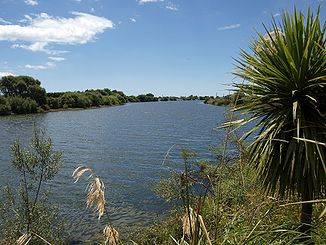Rangitaiki River
| Rangitaiki River | ||
|
Rangitaiki River between Edgecumbe and Thornton |
||
| Data | ||
| location | Bay of Plenty (Region) , North Island (New Zealand) | |
| River system | Rangitaiki River | |
| source | in the northern foothills of the Ahimanawa Range | |
| muzzle | north of Thornton in the Bay of Plenty Coordinates: 37 ° 54 ′ 32 " S , 176 ° 52 ′ 55" E 37 ° 54 ′ 32 " S , 176 ° 52 ′ 55" E
|
|
| length | 193 km | |
| Small towns | Murupara , Te Teko , Edgecumbe | |
At 193 km, the Rangitaiki River is the longest river in the Bay of Plenty region on the North Island of New Zealand .
geography
The river has its source 130 km from the coast of the Bay of Plenty, not far from Lake Pouarua at an altitude of 800 m in the northern foothills of the Ahimanawa Range . With a right turn, the river follows a north-easterly direction in the upper and middle reaches, runs west along the Te-Urewera National Park , and then flows in a northerly direction behind Thornton into the Pacific Ocean . On its upper course it passes the place Rangitaiki , which is considered to be the namesake of the river. Other places like Murupara , Te Teko and Edgecumbe lie further downstream on his way.
The Rangitaiki River drains with an average discharge of 70 m³ / sec. an area of 3005 km² and feeds two reservoirs in the central area , Lake Aniwhenua and Lake Matahina .

use
In the course of the further settlement of the plain between the Tarawera River and the Whakatane River , the wetlands on both sides of the river have been drained since the beginning of the 20th century, and the lower course of the river has been more and more straightened and diked. The Rangitaiki Plain was made agriculturally usable, but at the cost of the constant risk of flooding. This danger has increased due to more extreme weather conditions with considerable amounts of rain on the one hand and the lowering of the Edgecumbe area from seaward by up to 2 meters due to the Edgecumbe earthquake of March 2, 1987.
From the source to the mouth, the river counts among experts as an incomparable fishing area. Brown trout and rainbow trout with weights around 2 kg, often up to 5 kg, can be caught. Sea trout are preferred to be caught in the estuary area . Rafting is very popular in the upper course of the river and Murupara is a starting point for it, while further down the river the river is more suitable for canoeing and kayaking .
The Matahina dam , which was built in the 1960s to generate electricity , was designed for 72 MW of power. In the Edgecumbe earthquake in 1987, which had a magnitude of 6.5 on the Richter scale , the dam was damaged, lost water and had to be repaired in 1988. The second dam further up, the Aniwhenua dam, offers a power generation capacity of 25 MW and was opened in October 1980.
literature
- James Healy: Rangitaiki River . In: Alexander Hare McLintock (Ed.): An Encyclopaedia of New Zealand . Wellington 1966 ( online [accessed December 14, 2015]).
Individual evidence
- ^ David Young: Rivers - Types of river. In: Te Ara - the Encyclopedia of New Zealand. Ministry for Culture & Heritage , November 14, 2012, accessed May 12, 2014 .
- ↑ Eileen McSaveney: Historic earthquakes - The earthquake in 1987 Edgecumbe. In: Te Ara - the Encyclopedia of New Zealand. Ministry for Culture & Heritage, July 13, 2012, accessed May 12, 2014 .
- ^ Rangitaiki River Trout Fishing. nzfisching, accessed on January 27, 2010 (English).
- ^ Matahina Hydro Dam Seismic Hazard Assessment - New Zealand. Earthquake Engineering New Zealand, archived from the original on May 13, 2010 ; accessed on May 9, 2019 (English, original website no longer available).
- ^ Waitangi Tribunal - Department of Justice (ed.): Te Ika Whenua - Energy Assets Report 1993 . Wellington 1993 ( online [accessed February 12, 2018]).
